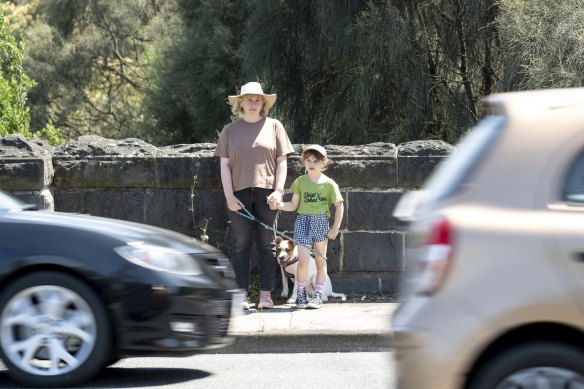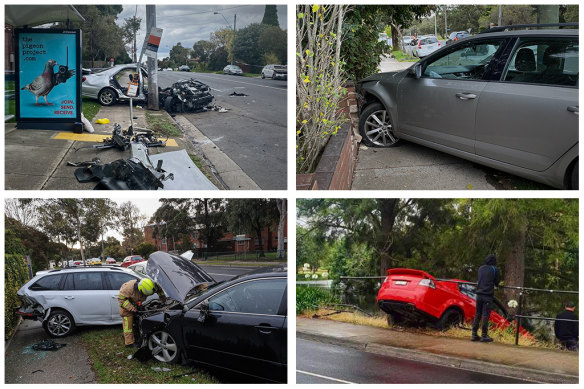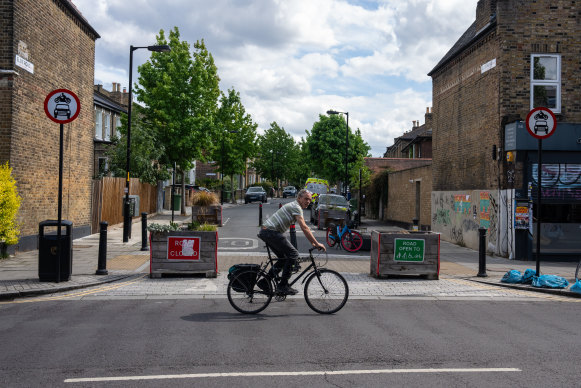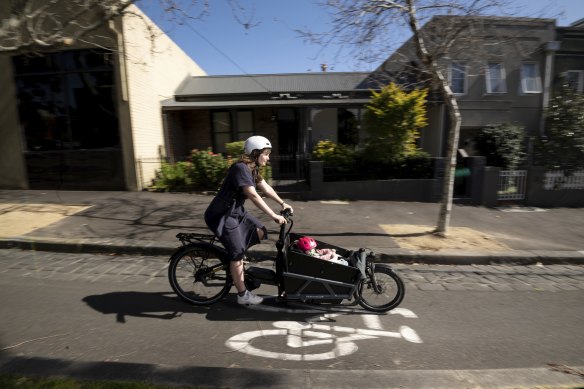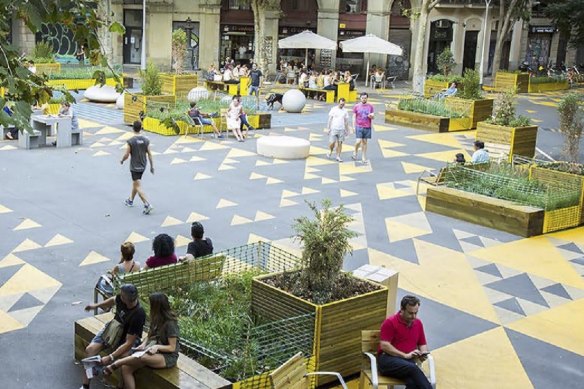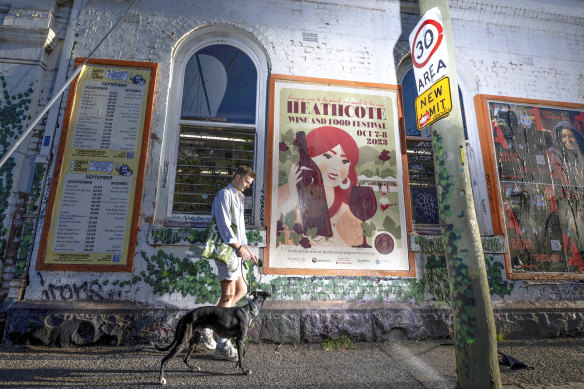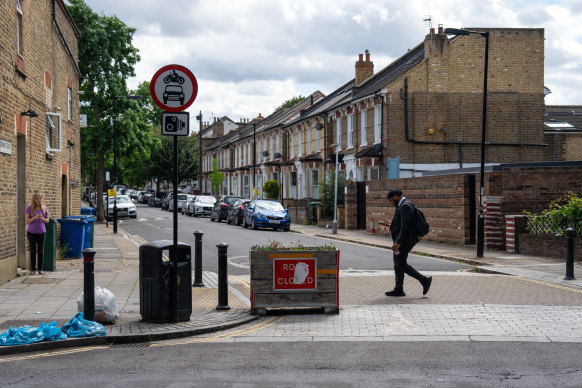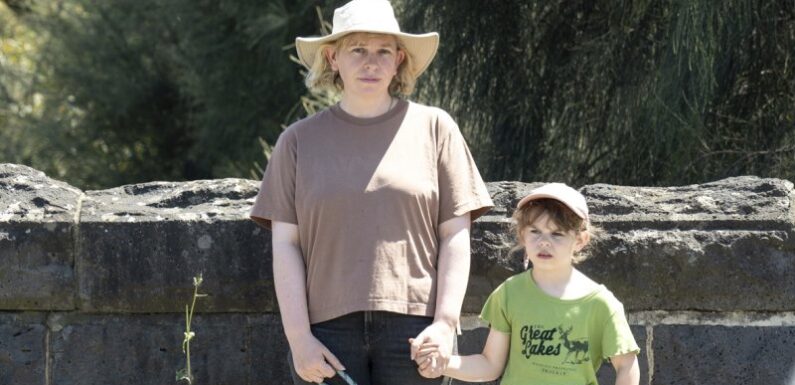
Save articles for later
Add articles to your saved list and come back to them any time.
Just before 8.30am most weekdays, Antonia Sellbach notices her heart rate start to rise as she takes her daughter in one hand, her dog in the other and steps out her front door.
It’s only a kilometre from their Coburg North home to six-year-old Albertine’s primary school.
Antonia Sellbach and her six-year-old daughter Albertine and their dog Hilda attempting to cross Murray Road in Coburg.Credit: Penny Stephens
But their journey starts by trying to cross Murray Road, a notorious 60km/h thoroughfare where cars speed just centimetres from the narrow footpaths families use to get to nearby schools, shops and parks.
Locals say the stretch became a “speed track” when VicRoads widened it from two lanes to four in 2011. Cars have ploughed into front fences, and there’s been at least eleven crashes there so far this year.
“I would never let her walk to school on her own – we don’t even play in our front yard,” says Sellbach. “You can’t leave the house without navigating that dangerous situation.”
The fear of being killed or seriously injured on Melbourne’s roads is a reasonable one. Last year, 106 people died in crashes in Melbourne, including 33 pedestrians, 31 motorcyclists and eight cyclists.
Photographs locals have taken of car crashes on Murray Road, Coburg.
Another 3392 people were hospitalised with injuries, according to the Transport Accident Commission.
Most of Victoria’s road deaths happen on country roads. Statewide, 258 people have died so far this year – a 20 per cent increase on this time last year – with 105 of those happening in Melbourne and 153 in rural areas.
Road crashes are the leading cause of death for Australian children aged one to 14 and the second-biggest killer of Australians aged 15 to 25.
The Age’s Home Safe series is examining how safe it is to live in Melbourne compared with a handful of major global cities, and how that impacts our quality of life.
London now has around 100 “low-traffic neighbourhoods”.Credit: Getty
On top of the deaths and life-changing injuries, people like Sellbach face the daily stress of dicing with a danger she says could be solved with better pedestrian crossings, wider footpaths and slowing down traffic.
“There are some simple things that can be done to make it safer and it’s just a bit ridiculous that they’re not already in place,” she says.
So when it comes to getting from A to B – whether that’s by car, foot, bicycle or public transport – would you rather do it here, or in London, Berlin, Barcelona, Tokyo and New York City?
Australasian College of Road Safety CEO Ingrid Johnston says the key data points show Melbourne is well behind most of those cities.
“There are clear differences and the risk is clearly higher in Melbourne,” she says. “There’s still a lot that you can do. One of the key things really is to have the community mindset that it’s just not OK that people die and we can prevent that.”
One way to judge a road network’s safety is to look at the number of annual fatalities per 100,000 people.
Melbourne’s average fatality rate over 2018, 2019 and 2021 is 2.42 deaths per 100,000 (2020 has been excluded because of the impact of COVID-19 lockdowns).
The figure shows Melburnians are twice as likely to die in road crashes than people in Barcelona (1.23 per 100,000), London (1.22), Berlin (1.06) and Tokyo (1.03), based on the most recently available data.
Melbourne is now about as dangerous as New York City (2.38 deaths). If it became as safe as Barcelona, we would save around 34 lives every year.
Professor Stuart Newstead, director of the Monash University Accident Research Centre, says this stark comparison shows how much catch-up Melbourne has to do.
“Despite Victoria thinking they’re winning the road safety race, they’re far behind when it comes to urban road safety,” he says.
Victoria, like authorities in all these cities and jurisdictions, has committed to “Vision Zero”, an international pledge to eliminate road deaths entirely by 2050.
And some progress has been made: the 106 lives lost in 2022 in Melbourne is a 17 per cent reduction from an average of 127 over the three years to 2012.
But there have been far bigger improvements in some of our comparison cities over the same period, with London achieving a 27 per cent reduction in deaths and Barcelona 45 per cent.
Newstead says that Melbourne’s sprawling geography makes road safety more of a challenge compared with the smaller, more densely populated comparison cities.
We spend more time travelling over greater distances. And our transport network revolves around cars – the most dangerous form of transport.
Walking and cycling make up just 19 per cent of trips.Credit: Penny Stephens
Across Greater Melbourne, 72 per cent of trips are made by private motor vehicles, nine per cent are by public transport, and 19 per cent are by walking or bike, according to Department of Transport and Planning surveys.
Berliners on the other hand drive for only 30 per cent of their journeys, use public transport for 22 per cent, walk for 31 per cent and bike for 13 per cent.
Victoria has 5.1 million registered motor vehicles, or a bit more than one vehicle for every person. While in Tokyo – which is easily the safest city on our list – there’s only 28 cars for every 100 people.
Newstead says that despite starting off with that disadvantage, there is still plenty Melbourne can do to make its transport system safer. That includes recognising the safety impact of car dependency.
Barcelona’s superblocks have turned roads into spaces for walking, cycling and community.
“People are basically forced into cars because they need to either travel extensive distances or because there’s no public transport options for them,” he says. “A big part of reducing urban road trauma is to get them onto safer forms of transport – and things like public transport are excellent.”
Looking at road deaths relative to how much driving we do presents a slightly different picture: we had an average of 2.6 deaths per billion kilometres driven between 2016 and 2020, which is lower than London’s 3.4, according to data compiled by the International Transport Forum.
‘Streets and roads are our public space.’
The TAC’s head of road safety, Samantha Cockfield, says Victoria has made roads safer with lower speed limits, public awareness campaigns, infrastructure like safety barriers and median separations, and increased police enforcement.
“Melbourne has a larger area and a smaller population, meaning the road environments are different to other major cities,” she said in a statement.
But drilling down further into the data shows that any reduction in road deaths has been for motorists, with their fatalities falling from an average of 71 in the three years to 2012, to 33 in 2022.
There’s been no improvement for other road user groups. Pedestrian casualties have increased slightly, from 29 to 33 a year. Cyclist casualties have grown from five to eight, and motorcyclist deaths have jumped from 21 to 25.
Over the same period, London reduced pedestrian deaths by 40 per cent, saving 27 lives every year, and reduced bike rider deaths from 13 to 7.
That’s happened even as the number of people using bikes to get around London grew 50 per cent. Transport authorities say cycling has become safer and more popular because of the hundreds of kilometres of protected bike lanes it has installed.
The difference is even starker when we consider that people in the comparison cities do far more walking than we do, including at the beginning and end of their public transport trips.
Melbourne’s rate of pedestrian deaths per billion walking journeys was 39.7 deaths in 2018 – almost double London’s rate of 23.3 and four times Barcelona’s rate of 10.7 in 2015, according to data compiled by the ITF.
A 30km/h trial in the City of Yarra is being extended.Credit: Penny Stephens
Johnston says it’s clear we’ve not done enough to protect those vulnerable road users. She says Melbourne should be taking its lead from what has worked in the best-performing comparison cities, starting with their lower speed limits.
Barcelona was one of the first places in the world to roll out 30km/h limits in 2006, London has already lowered nearly half its road network to 20mph (32km/h), and Berlin is also introducing it in places.
But Victoria’s default urban limit is 50km/h on local streets, while many suburban arterial roads are 60km/h or faster.
Melbourne has been gradually rolling out 40km/h zones in parts of the city, and that limit was applied across the whole CBD in 2012. But the only 30km/h streets are in a trial area within a pocket of the City of Yarra, in the inner north.
Research indicates that a pedestrian or cyclist has a 90 per cent likelihood of being killed if hit by a car at 50km/h, a 40 per cent chance of being killed at 40km/h and only a 10 per cent chance of being killed at 30km/h.
“It decreases the likelihood of crash, it decreases the consequences if a crash occurs, and it makes it so much safer both for drivers and also for those who aren’t in vehicles,” Johnston says. “You’ve only got to look at the cities internationally where they’ve done it and the response is instant in trauma rates – it’s undeniable.”
Transport for London, the city authority, says the number of collisions causing deaths or serious injuries fell 24 per cent after it lowered speed limits from 30mph to 20mph in part of the city centre in 2020, compared to a 10 per cent reduction citywide.
Yarra councillors this week voted to extend the limit across Collingwood and Fitzroy and published data showing a 70 per cent reduction in serious crashes in its trial so far.
A 30km/h limit can only be used as part of trials with state government approval, because it is not yet a standard speed in Victoria’s Speed Zoning Policy. NSW added 30km/h to its speed limit guidelines in July, so it can be applied in busy pedestrian areas more easily.
A low traffic neighbourhood in London.Credit: Getty
But, like in other cities, moving to that limit won’t come without a backlash, with even Victoria Police Chief Commissioner Shane Patton calling it “ridiculous” on Thursday.
Minister for Roads and Road Safety Melissa Horne wouldn’t comment on expanding Yarra’s 30km/h trial but said the state government was working on a new Road Safety Action Plan and would “always consider road safety initiatives to keep Victorians safe”.
“We know that speed results in unnecessary death and devastating injury on our roads – particularly when it comes to vulnerable road users, like pedestrians,” she said in a statement.
Newstead agrees that Melbourne’s speed limits are “the big elephant in the room” and needed to be lowered in built-up areas, unless there are bike lanes and footpaths that fully separate vehicles from people.
The same is true on many main arterial roads, he says. Each morning he drives on one such road where motorists can pull out of side streets directly into 80km/h traffic.
“A side-impact collision at that speed would have severe outcomes,” he says. “So you’ve either got to spend an awful lot of money fixing those design issues, or you’ve got to take the speed limits down.”
New York has reduced its pedestrian fatalities to record lows, even as they skyrocketed across other parts of the US, with an infrastructure blitz that’s included upgrading more than 1400 intersections in 2022 alone with better signalling, raised crossings, designs to slow down turning vehicles and by removing some car parking to improve visibility.
It’s also significantly stepped up enforcement of road rules: police doubled the number of driving fines issued between 2013 and 2018, and the city has recently turned on school zone speed cameras 24/7.
Victoria Walks executive officer Ben Rossiter says that beyond lower speed limits and better infrastructure, our best safer comparison cities have designed their streets around people, not just the movement of vehicles.
“Streets and roads are our public space, and they give people more options to travel by making walking safer and easier,” he says.
Barcelona, famously, has implemented a strategy of creating “superblocks”, where traffic is restricted to local access and deliveries, creating space for walking, cycling, public transport and – just as importantly – places where communities can meet and socialise.
A similar thinking is behind London’s 100 “low-traffic neighbourhoods”. Along with significantly improved air quality, traffic injuries have halved and pedestrian injuries fell 85 per cent, according to Transport for London.
Tokyo’s streets are considered so safe not just because there are so few cars, but also very little on-street parking, making it easier for all road users to see each other.
In contrast, Rossiter said Murray Road was a perfect example of how Melburnians lived with roads that were too wide, too fast and did not separate vehicles from people.
“If we want to seriously reduce road trauma and increase the level of sustainable trips – walking or bike riding – we actually have to address areas like that,” he says. “A lot of parents are not going to feel comfortable letting their kids walk and ride, so it’s an equity issue.”
Get the day’s breaking news, entertainment ideas and a long read to enjoy. Sign up to receive our Evening Edition newsletter.
Most Viewed in National
From our partners
Source: Read Full Article
